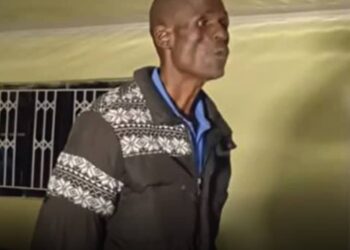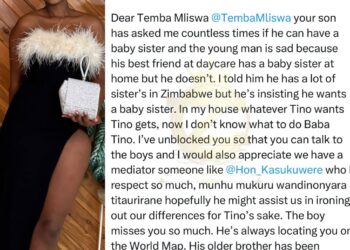WIPING his dusty face and shaking his muddied clothes, Owen Jaison (24) takes a huge sigh of relief.
He had just dug his way out of belly of the earth for a kilometre.
He and other 14 artisanal miners had been trapped underground for three days after a mine shaft to a tunnel they were working in collapsed at Tsapauta in Penhalonga, Manicaland province.
For Jaison, who had not known daylight but only the tomb darkness of the earth’s belly, the events of January 4 to 8, 2024 were a journey to hell and back.
The artisanal miner, from Insiza district in Matebeleland South province, more than 460km away, was among 15 miners who miraculously escaped death through providence at Redwing Mine, and today he lives to testify how their maker assisted them to again walk on earth.
Narrating the scary ordeal which sounded like a script from a horror movie, Jaison believes that their escape from the jaws of death was, indeed, a miracle.
“It can only be God. It was a miracle and I now believe that miracles do happen,” he said.
It all began in the early hours of January 4 when he and his colleagues were mining underground.
“We heard a noise and realised that the shaft pillars were falling. We sensed that we were in danger,” he recalled.
“The ground was wet and the walls of the shaft continued caving in towards us. The opening of the shaft was closed by sand and we had nowhere to go. So we went deeper into the mine looking for escape tunnels, but to no avail. There was no time to sleep as we were determined to survive.”
Fear of underground explosions, gas poisoning, suffocation and mine walls caving in on them haunted them each passing day.
For food, they survived on underground tree roots.
“There was no time to sleep as we looked for tunnels to escape. We ate roots of trees and drank dirty water. Some wept uncontrollably, while others were mired in confusion,” Jaison narrated.
“We told ourselves that we had to be psychologically strong. We prayed to God to give us more strength. We developed hope and the quest for survival kept us going.”
By day three, most of them were exhausted and weak.
“We prayed harder and told ourselves that we had to survive, otherwise we were going to die. The ground continued cave in. So we had to go the other side where the ground was still intact. As we crept, pushing against the narrow walls, we noticed a crack and we went to investigate. We realised that the crack had been caused by the collapsed shaft,” he said.
Hope was rekindled in the 15 miners.
“We took rods and sticks and started digging into the crack. We dug up and crawled up the crack. There were four of us who first went up the crack. We held each other’s hands as we dug and crawled up. It was not easy, but we had to survive,” Jaison chronicled.
They spent hours digging like frenzied rats into the crack, determined to reach the surface.
“It was so painful to dig up the crack. Our bodies became weak because of hunger and severe thirst. Some of the younger miners were gripped with the panic of death,” he continued to recall their harrowing experience which left their arms and legs throbbing.
“When we realised that we were almost reaching the surface, we shouted to our colleagues to follow us. The four of us then managed to break out and crawled out to the surface through the crack. We then saw some people who were moving around searching for us and we shouted for help,” Jaison said.
“That is when we told them that the other guys were behind us. Fortunately, nine miners came out the way we did. There were two left who could not make it due to fatigue, that is when the rescue team was notified and they brought a rope to pull them out. That is how we survived,” he narrated.
As the miners went to the Red Cross tent to receive medical attention, they were evidently thrilled to have cheated death.
Residents of the area hysterically celebrated, while other relatives of the lucky 15 who had travelled from far and wide shed tears of utter joy after seeing their loved ones alive.
“I came all the way from Mazowe after I read in the newspaper that there were miners trapped here. My brother was part of the trapped miners. I am happy that he is alive. This is very unbelievable because as a family, we had lost all hope,” said Tawanda Siziba.
Although Mines and Mining Development minister Zhemu Soda has since suspended mining activities at Redwing Mine, investigations by this publication have revealed that illegal mining facilitated by political elites and politically-connected groups continues at the ill-fated mine.
They all seem unperturbed by Jaison and his colleagues’ harrowing experience.
Community-based organisations in Manicaland have said the mining operations at Redwing Mine are in complete violation of Statutory Instrument 109 of 1990 (Management and Safety) Regulations, 190.
They have since called for the immediate stoppage of artisanal mining operations and challenged the government to effect accountability measures to save lives.
“There is no barricading to working sites and steep inclined shafts, no protection to blasting fumes, dust and gases, no protective clothing including lifeline and life jackets, no precautionary measures in working distances of less than 10 metres, no adequate timbering to prevent fall of ground among other issues,” said Centre for Research and Development director James Mupfumi.
Redwing Mine, one of the many eldorados in Zimbabwe, is teeming with hundreds of artisanal miners who travel from all parts of the country to risk their lives to make ends meet by mining for gold they sell to political heavyweights.
The areas has been so lucrative for both the miners and politicians that bringing sanity to the area will be a hard slog given the bad state of the country’s economy.
Many were not so lucky like Jaison and his colleagues, having died in the area, a lesson Jaison will forever cherish having been given another chance to walk the earth.
Jaison has decided to take a break from artisanal mining.
“I cannot gamble my life again, I survived the worst, I was given another chance to live,” he said.










